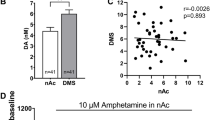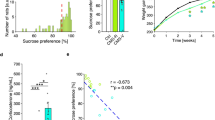Abstract
Preclinical studies have shown that stress and glucocorticoids increase mesolimbic dopamine (DA) and thereby facilitate psychostimulant self-administration. The relationship between stress-induced cortisol and mesolimbic DA responses to psychostimulants has not been studied in humans. To test the hypotheses that glucocorticoid responses to psychological stress are correlated with DA and subjective responses to psychostimulants in humans, 25 healthy adults (18–29 years) completed the Trier Social Stress Test (TSST) and two positron emission tomography (PET) scans with high-specific [11C]raclopride. The first scan was preceded by intravenous saline and the second by amphetamine (AMPH). Findings showed that stress-induced cortisol levels were positively associated with AMPH-induced DA release in the ventral striatum and other striatal regions. Subjects with higher cortisol responses to stress also reported more positive subjective drug effects with AMPH than subjects with lower responses. The results are consistent with preclinical findings showing an interrelationship between glucocorticoids and mesolimbic DA dynamics, which may influence psychostimulant self-administration in humans.
Similar content being viewed by others
Log in or create a free account to read this content
Gain free access to this article, as well as selected content from this journal and more on nature.com
or
References
Barrot M, Marinelli M, Abrous DN, Rouge-Pont F, Le Moal M, Piazza PV (2000). The dopaminergic hyper-responsiveness of the shell of the nucleus accumbens is hormone-dependent. Eur J Neurosci 12: 973–979.
Baumann B, Danos P, Krell D, Diekmann S, Leschinger A, Stauch R et al (1999). Reduced volume of limbic system-affiliated basal ganglia in mood disorders: preliminary data from a postmortem study. J Neuropsychiatry 11: 71–78.
Bonci A, Bernardi G, Grillner P, Mercuri NB (2003). The dopamine-containing neuron: maestro or simple musician in the orchestra of addiction? Trends Pharmacol Sci 24: 172–177.
Breese GR, Chu K, Dayas CV, Funk D, Knapp DJ, Koob GF et al (2005). Stress enhancement of craving during sobriety: a risk for relapse. Alcohol Clin Exp Res 29: 185–195.
Bucholz KK, Cadoret R, Cloninger CR, Dinwiddie SH, Hesselbrock VM, Nurnberger Jr JI et al (1994). A new, semi-structured psychiatric interview for use in genetic linkage studies: a report on the reliability of the SSAGA. J Stud Alcohol 55: 149–158.
Cadoni C, Solinas M, Valentini V, Di CG (2003). Selective psychostimulant sensitization by food restriction: differential changes in accumbens shell and core dopamine. Eur J Neurosci 18: 2326–2334.
Cador M, Cole BJ, Koob GF, Stinus L, Le MM (1993). Central administration of corticotropin releasing factor induces long-term sensitization to D-amphetamine. Brain Res 606: 181–186.
Cho K, Little HJ (1999). Effects of corticosterone on excitatory amino acid responses in dopamine-sensitive neurons in the ventral tegmental area. Neuroscience 88: 837–845.
Cropley VL, Fujita M, Innis RB, Nathan PJ (2006). Molecular imaging of the dopaminergic system and its association with human cognitive function. Biol Psychiatry 59: 898–907.
Cuadra G, Zurita A, Gioino G, Molina V (2001). Influence of different antidepressant drugs on the effect of chronic variable stress on restraint-induced dopamine release in frontal cortex. Neuropsychopharmacology 25: 384–394.
de Quervain DJ, Henke K, Aerni A, Treyer V, McGaugh JL, Berthold T et al (2003). Glucocorticoid-induced impairment of declarative memory retrieval is associated with reduced blood flow in the medial temporal lobe. Eur J Neurosci 17: 1296–1302.
Deroche-Gamonet V, Sillaber I, Aouizerate B, Izawa R, Jaber M, Ghozland S et al (2003). The glucocorticoid receptor as a potential target to reduce cocaine abuse. J Neurosci 23: 4785–4790.
Endres CJ, Kolachana BS, Saunders RC, Su T, Weinberger D, Breier A et al (1997). Kinetic modeling of [11C]raclopride: combined PET-microdialysis studies. J Cereb Blood Flow Metab 17: 932–942.
Erixon-Lindroth N, Farde L, Wahlin TB, Sovago J, Halldin C, Backman L (2005). The role of the striatal dopamine transporter in cognitive aging. Psychiatry Res 138: 1–12.
Federenko IS, Nagamine M, Hellhammer DH, Wadhwa PD, Wust S (2004). The heritability of hypothalamus pituitary adrenal axis responses to psychosocial stress is context dependent. J Clin Endocrinol 89: 6244–6250.
Goeders NE, Peltier RL, Guerin GF (1998). Ketoconazole reduces low dose cocaine self-administration in rats. Drug Alcohol Depend 53: 67–77.
Gordon W (2002). Early environmental stress and biological vulnerability to drug abuse. Psychoneuroendocr 27: 115–126.
Iversen L (1979). The chemistry of the brain. Sci Am 241: 134–149.
Karlsgodt KH, Lukas SE, Elman I (2003). Psychosocial stress and the duration of cocaine use in non-treatment seeking individuals with cocaine dependence. Am J Drug Alcohol Abuse 29: 539–551.
Kirschbaum C, Pirke KM, Hellhammer DH (1993). The ‘Trier Social Stress Test’—a tool for investigating psychobiological stress responses in a laboratory setting. Neuropsychobiology 28: 76–81.
Kosten TA, Zhang XY, Kehoe P (2003). Chronic neonatal isolation stress enhances cocaine-induced increases in ventral striatal dopamine levels in rat pups. Brain Res Dev Brain Res 141: 109–116.
Kuikka JT, Repo E, Bergstrom KA, Tupala E, Tiihonen J (2000). Specific binding and laterality of human extrastriatal dopamine D2/D3 receptors in late onset type 1 alcoholic patients. Neurosci Lett 292: 57–59.
Kuwabara H, Rousset OKA, Alexander M, Wong DF (2004). A method for estimating accuracy of intra and inter modality image volume registration. J Nucl Med 45: 393.
Leyton M, Boileau I, Benkelfat C, Diksic M, Baker G, Dagher A (2002). Amphetamine-induced increases in extracellular dopamine, drug wanting, and novelty seeking: a PET/[11C]raclopride study in healthy men. Neuropsychopharmacology 27: 1027–1035.
Marinelli M, Piazza PV, Deroche V, Maccari S, Le MM, Simon H (1994). Corticosterone circadian secretion differentially facilitates dopamine-mediated psychomotor effect of cocaine and morphine. J Neurosci 14: 2724–2731.
Martinez D, Broft A, Foltin RW, Slifstein M, Hwang DR, Huang Y et al (2004). Cocaine dependence and d2 receptor availability in the functional subdivisions of the striatum: relationship with cocaine-seeking behavior. Neuropsychopharmacology 29: 1190–1202.
Martinez D, Slifstein M, Broft A, Mawlawi O, Hwang DR, Huang Y et al (2003). Imaging human mesolimbic dopamine transmission with positron emission tomography. Part II: amphetamine-induced dopamine release in the functional subdivisions of the striatum. J Cereb Blood Flow Metab 23: 285–300.
Mehta MA, Manes FF, Magnolfi G, Sahakian BJ, Robbins TW (2004). Impaired set-shifting and dissociable effects on tests of spatial working memory following the dopamine D2 receptor antagonist sulpiride in human volunteers. Psychopharmacology (Berl) 176: 331–342.
Mesulam M (2000). Brain, mind, and the evolution of connectivity. Brain Cogn 42: 4–6.
Monchi O, Petrides M, Strafella AP, Worsley KJ, Doyon J (2006). Functional role of the basal ganglia in the planning and execution of actions. Ann Neurol 59: 257–264.
Mozley LH, Gur RC, Mozley PD, Gur RE (2001). Striatal dopamine transporters and cognitive functioning in healthy men and women. Am J Psychiatry 158: 1492–1499.
Munro CA, McCaul ME, Wong DF, Oswald LM, Zhou Y, Brasic J et al (2006). Sex differences in striatal dopamine release inhealthy adults. Biol Psychi 59: 966–974.
Oswald LM, Wong DF, McCaul M, Zhou Y, Kuwabara H, Choi L et al (2005). Relationships among ventral striatal dopamine release, cortisol secretion, and subjective responses to amphetamine. Neuropsychopharmacology 30: 821–832.
Piazza PV, Le MM (1998). The role of stress in drug self-administration. Trends Pharmacol Sci 19: 67–74.
Piazza PV, Marinelli M, Rouge-Pont F, Deroche V, Maccari S, Simon H et al (1996). Stress, glucocorticoids, and mesencephalic dopaminergic neurons: a pathophysiological chain determining vulnerability to psychostimulant abuse. NIDA Res Monogr 163: 277–299.
Pruessner JC, Champagne F, Meaney MJ, Dagher A (2004). Dopamine release in response to a psychological stress in humans and its relationship to early life maternal care: a positron emission tomography study using [11C]raclopride. J Neurosci 24: 2825–2831.
Saal D, Dong Y, Bonci A, Malenka RC (2003). Drugs of abuse and stress trigger a common synaptic adaptation in dopamine neurons. Neuron 37: 577–582.
Sarnyai Z, Shaham Y, Heinrichs SC (2001). The role of corticotropin-releasing factor in drug addiction. Pharmacol Rev 53: 209–243.
Schad CA, Justice Jr JB, Holtzman SG (2002). Endogenous opioids in dopaminergic cell body regions modulate amphetamine-induced increases in extracellular dopamine levels in the terminal regions. J Pharmacol Exp Ther 300: 932–938.
Schmitz Y, Lee CJ, Schmauss C, Gonon F, Sulzer D (2001). Amphetamine distorts stimulation-dependent dopamine overflow: effects on D2 autoreceptors, transporters, and synaptic vesicle stores. J Neurosci 21: 5916–5924.
Schommer NC, Hellhammer DH, Kirschbaum C (2003). Dissociation between reactivity of the hypothalamus–pituitary–adrenal axis and the sympathetic–adrenal–medullary system to repeated psychosocial stress. Psychosom Med 65: 450–460.
Sinha R, Garcia M, Paliwal P, Kreek MJ, Rounsaville BJ (2006). Stress-induced cocaine craving and hypothalamic–pituitary–adrenal responses are predictive of cocaine relapse outcomes. Arch Gen Psychiatry 63: 324–331.
Sinha R, Talih M, Malison R, Cooney N, Anderson GM, Kreek MJ (2003). Hypothalamic–pituitary–adrenal axis and sympatho-adreno-medullary responses during stress-induced and drug cue-induced cocaine craving states. Psychopharmacology 170: 62–72.
Soderpalm A, Nikolayev L, de WH (2003). Effects of stress on responses to methamphetamine in humans. Psychopharmacology 170: 188–199.
Spielberger CD (1983). State-Trait Anxiety Inventory (Form Y). Consulting Psychologists Press: Palo Alto, CA.
Stark R, Wolf OT, Tabbert K, Kagerer S, Zimmermann M, Kirsch P et al (2006). Influence of the stress hormone cortisol on fear conditioning in humans: evidence for sex differences in the response of the prefrontal cortex. Neuroimage 32: 1290–1298.
Sussman S, Dent CW (2000). One-year prospective prediction of drug use from stress-related variables. Subst Use Misuse 35: 717–735.
Tiihonen J, Kuikka J, Hakola P, Paanila J, Airaksinen J, Eronen M et al (1994). Acute ethanol-induced changes in cerebral blood flow. Am J Psychiatry 151: 1505–1508.
Tiihonen J, Vilkman H, Rasanen P, Ryynanen OP, Hakko H, Bergman J et al (1998). Striatal presynaptic dopamine function in type 1 alcoholics measured with positron emission tomography. Mol Psychiatry 3: 156–161.
Verhoeff NP, Kapur S, Hussey D, Lee M, Christensen B, Papatheodorou G et al (2001). A simple method to measure baseline occupancy of neostriatal dopamine D2 receptors by dopamine in vivo in healthy subjects. Neuropsychopharmacology 25: 213–223.
Volkow ND, Fowler JS, Wang GJ, Swanson JM (2004). Dopamine in drug abuse and addiction: results from imaging studies and treatment implications. Mol Psychiatry 9: 557–569.
Volkow ND, Gur RC, Wang GJ, Fowler JS, Moberg PJ, Ding YS et al (1998). Association between decline in brain dopamine activity with age and cognitive and motor impairment in healthy individuals. Am J Psychiatry 155: 344–349.
Volkow ND, Wang GJ, Ma Y, Fowler JS, Zhu W, Maynard L et al (2003). Expectation enhances the regional brain metabolic and the reinforcing effects of stimulants in cocaine abusers. J Neurosci 23: 11461–11468.
Wendt PE, Risberg J, Stenberg G, Rosen I, Ingvar DH (1994). Ethanol reduces asymmetry of visual rCBF responses. J Cereb Blood Flow Metab 14: 963–973.
Wise RA (1998). Drug-activation of brain reward pathways. Drug Alcohol Depend 51: 13–22.
Yavich L, Tiihonen J (2000). Ethanol modulates evoked dopamine release in mouse nucleus accumbens: dependence on social stress and dose. Eur J Pharmacol 401: 365–373.
Acknowledgements
This work was supported by AA10158 (GSW), AA12837 (MEM), AA12839 (DFW) and GCRC (NIH/NCRR M01RR00052).
Author information
Authors and Affiliations
Corresponding author
Rights and permissions
About this article
Cite this article
Wand, G., Oswald, L., McCaul, M. et al. Association of Amphetamine-Induced Striatal Dopamine Release and Cortisol Responses to Psychological Stress. Neuropsychopharmacol 32, 2310–2320 (2007). https://doi.org/10.1038/sj.npp.1301373
Received:
Revised:
Accepted:
Published:
Issue date:
DOI: https://doi.org/10.1038/sj.npp.1301373
Keywords
This article is cited by
-
Cannabidiol versus placebo as adjunctive treatment in early psychosis: study protocol for randomized controlled trial
Trials (2023)
-
Modulation of behavioral and neurochemical responses of adult zebrafish by fluoxetine, eicosapentaenoic acid and lipopolysaccharide in the prolonged chronic unpredictable stress model
Scientific Reports (2021)
-
High Recreational Gamblers Show Increased Stimulatory Effects of an Acute Laboratory Gambling Challenge
Journal of Gambling Studies (2021)
-
Early Life Stress and Substance Use Disorders: Underlying Neurobiology and Pathways to Adverse Outcomes
Adversity and Resilience Science (2020)
-
The relationship between childhood trauma, dopamine release and dexamphetamine-induced positive psychotic symptoms: a [11C]-(+)-PHNO PET study
Translational Psychiatry (2019)



